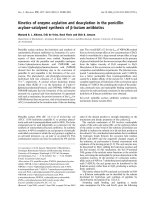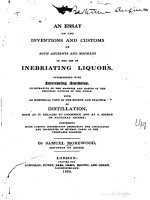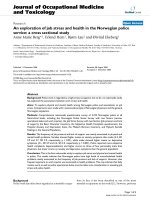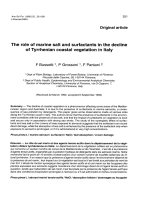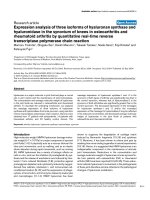Adaptation of land use and houses in the upper mekong deltas deep flooding area 2
Bạn đang xem bản rút gọn của tài liệu. Xem và tải ngay bản đầy đủ của tài liệu tại đây (12.55 MB, 65 trang )
Adaptation of land use and houses in the upper Mekong Delta’s deep flooding area
Chapter4.CurrentAdaptationtoFloods
This chapter studies current flood adaptation strategies in land use planning
and housing practices in the studied area. This is obtained through literature review
on adaptation of land use and houses, site visits, sketches, and interviews of 47
households in the Mekong Delta. Figure 43 and Figure 44 present the location of the
studied area and houses in the administrative and flood maps.
Section 4.1 studies infrastructure development and its impact on floods while
Section 4.2 examines the community in the studied area. Then, Section 4.3 explores
adaptation of houses by analyzing houses from different aspects that have impacts
on adaptation. Based on these analyses and evaluation criteria of safe shelter,
ensuring connectivity, and supporting livelihoods, Section 4.4 discusses the
limitations of current adaptation strategies.
Figure 43. Location of the studied area and houses
Source: NAGECCO (1998)
69
Adaptation of land use and houses in the upper Mekong Delta’s deep flooding area
Figure 44. Location of studied area and houses studied in the flood map for year 2000
Source: Author (based on maps of SIWRP)
4.1.Adaptationoflanduse:Infrastructuredevelopment
dealingwithfloods
This section studies the flood control planning and infrastructure in the
studied area and its impacts on floods, socio-economic development and the
environment.
4.1.1.Floodcontrolinfrastructuredevelopment
Infrastructure in the Mekong Delta has been developed for flood control and
agriculture intensification, especially since 1990s. In the studied area, year-round
flood protection is provided in the urban areas, for main transportation systems, and
the fruit tree areas. This is achieved by constructing full dykes9, main roads or
landfills higher than flood peak levels in 1996 and 2000 (Figure 45, Figure 46 and
Figure 47). Full dykes protect the farms from floods completely, with the control of
sluice gates and pumps, enabling three rice crops per year. Outside the above areas,
9
Full dykes (high dykes) are dykes constructed higher than peak flood levels, protecting the areas
from floods all year round. They are usually combined with roads and residential dykes.
70
Adaptation of land use and houses in the upper Mekong Delta’s deep flooding area
partial flood control solution, which protects the rice crops from early floods in
August and late floods in November-December, is possible with semi-dyke systems
(Figure 48). At the end of July and beginning of August, rice crops are ready for
harvest, if floods happened early and there are no dykes, crops would be damaged.
Therefore, semi-dykes are constructed around the level of floods in this time,
protecting the areas from early floods. After harvesting, floods overflow semi-dykes
into the fields. The semi-dykes also protect the farms from late floods in November
– December, so that farmers can start cultivating the next crop. Semi-dyke systems
help decrease the flood duration for agricultural production, ensuring two crops of
rice (SIWRP 1998b; To 1998). In the studied area, 67% of the dykes are semi-dykes
with an average level of about 2.5 m.a.s.l, and the rest are full dykes with an average
level of about 4.5 m.a.s.l. Moreover, there are more than 1000 man-made canals in
the Mekong Delta, which have been used for flood drainage, irrigation, and
transportation (Le et al. 2008).
Figure 45. Preliminary design of dykes in Tam Nong District
Source: MRC (2009)
Figure 46. A main road
combined with dyke in Tam
Nong District
Source: Author (Tam Nong
District, November 11, 2009)
71
Adaptation of land use and houses in the upper Mekong Delta’s deep flooding area
Figure 47. Local road combined with semi‐dyke, canal system, and high elevated area in the
studied area
Source: Author (Tam Nong District, December 01, 2009)
Figure 48. Flood control infrastructure of the studied area in 2004
Source: SIWRP (2010)
In the studied area, during 1996-2000, early flood prevention embankments
were constructed, and the Tan Thanh – Lo Gach canal was dredged (Figure 49).
After 2000, major changes in infrastructure include further dredging of canals, and
the expansion and raising of Road No. 30 to exceed the peak flood levels in 2000
(5.23 meters amsl at Tan Chau) (Figure 50). Soil obtained from dredging canals is
used to elevate the roads, and to build embankments along canals and along
residential areas (Le et al. 2008).
72
Adaptation of land use and houses in the upper Mekong Delta’s deep flooding area
Figure 49. Infrastructural change in the Mekong Delta: (a) during 1996 – 2000
Source: Le et al. (2008)
Figure 50. Infrastructural change in the Mekong Delta: (b) after 2000
Source: Le et al. (2008)
73
Adaptation of land use and houses in the upper Mekong Delta’s deep flooding area
4.1.2.Impactsoffloodcontrolinfrastructureonfloods
Figure 51, Figure 52, Figure 53, and Figure 54 illustrate average elevations
of dykes in Tam Nong and Tan Hong districts, with simulated water levels in the
historical 97 years under current infrastructure in the Mekong Delta. The average
elevations of dykes in Tam Nong and Tan Hong are about 2.4 meters and 3 meters,
respectively. These dykes can protect the area from the early floods in August, for
roughly 90 percent of flood water levels simulated. This also implies that semidykes account for the majority of dykes in the studied area.
Figure 51. Average elevations of dykes in Tam Nong District and simulated max water levels in the
historical 97 years under current infrastructure situation
Source: MRC (2009)
Figure 52. Average elevations of dykes in Tam Nong District and simulated water levels in August
in the historical 97 years under current infrastructure situation
Source: MRC (2009)
74
Adaptation of land use and houses in the upper Mekong Delta’s deep flooding area
Figure 53. Average elevations of dykes in Tan Hong District and simulated max Figure 54. Average elevations of dykes in Tan Hong District and simulated water
levels in August in the historical 97 years under current infrastructure situation
water levels in the historical 97 years under current infrastructure situation
Source: MRC (2009)
Source: MRC (2009)
Figure 55. Flood control infrastructure in a nice flood10 in the studied area
Source: Author
10
Nice floods have peak flood levels from 3.5 to 4.5 m, which bring fertile sediments, fishery resources, and renew the water and soil quality of the farmland (Please
refer to Section 2.3.1.1 for more details).
75
Adaptation of land use and houses in the upper Mekong Delta’s deep flooding area
Figure 55 illustrates the flood control infrastructure in a nice flood11 in transsections12 of the studied area. It shows high elevated roads, elevated residential or
urban areas, and areas protected by full dykes, which are higher than flood peak
levels in 1996 or 2000, hence they are not affected by floods. It also shows that areas
protected by semi dykes areas with low elevation of the roads and ground, and areas
not protected are inundated by peak levels of a nice flood. Section 4.3.2.1 further
discusses how houses in these areas are affected by floods.
Le et al. (2008) examined the impacts of infrastructure on floods in the
Mekong Delta based on the analysis of flood variation from 1961 to 2004 and
effects of infrastructure changes from 1996 to 2001 using hydraulic model
HydroGIS. It is suggested that these engineering structures make the flood duration
approximately 5–10 days longer and water level 0.2–0.3 m deeper in some areas
near or between the high embankment systems. Floods are reduced in areas
protected by embankments and increased in water level and duration in other areas
such as downstream of Dong Thap Muoi towards the Vam Co River, because the
engineering structures make changes to the flow and obstruct drainage. Another
impact is overbank inflow to Vietnam is decreased and water flow in the canals is
increased, resulting in a trend of increase with progression in flood peaks
downstream (Le et al. 2008).
11
Based on Tan Chau station’s flood level, floods can be classified into four categories, including
dreadful floods, damaging floods, nice floods and light floods when flood level is more than 5 m, 4.5
to 5 m, 3.5 to 4.5 m, and less than 3.5 m, respectively. The “nice” floods bring fertile sediments,
fishery resources, and renew the water and soil quality of the farmland while the “damaging” floods
or “serious” damage properties and infrastructure. The “dreadful” floods cause heavy human
casualties and severe damage to infrastructure. In the “light” floods, fishery production decreases, the
soil is less fertile, and salinity increases (Please refer to Section 2.3.1.1 for more details).
12
The trans-section is combined from typical sections of houses in the studied area
76
Adaptation of land use and houses in the upper Mekong Delta’s deep flooding area
4.1.3.Impactsoffloodcontrolinfrastructureinthestudiedarea
Positiveimpacts
Changes in infrastructure mentioned above have significant impacts on
agricultural practices and flooding in the Mekong Delta. Flood control infrastructure
in the studied area has benefited socio-economic development, protected people,
infrastructure and houses, and supplied fresh water. Thanks to dyke systems and
hydraulic constructions, rice production has almost quadrupled from 1974 to 2005
(Nguyen 2007a), and damages caused by floods have reduced substantially.
Elevated roads ensure convenient transportation and connections of inhabitants to
public services in the flooding season.
Negativeimpacts
Although the current strategy dealing with flood in the Mekong Delta is a
combination of “Living with floods” and flood control, the numerous measures of
flood control and underestimation of the complexity of the Mekong Delta’s ecology
have resulted in numerous drawbacks and challenges to the area’s environment and
flood regime. These measures have brought about a decrease in fishery resources
and sediments in the flood control area (To 1998), as well as soil acidification, water
pollution, and increase in insects and vermin in the rice fields. Recently, yields have
decreased, in some cases to 25-50 kg per 1000 m2. Due to decrease in sedimentation,
more chemical fertilizers and insecticides were used, leading to higher production
cost and harm to the environment. In addition, full dyke protection may constrain
water transportation (Le and Chu et al. 2007).
In conclusion, the main strategies for coping with flood in the studied area
are building semi-dyke systems to control early floods, and using canals for quick
77
Adaptation of land use and houses in the upper Mekong Delta’s deep flooding area
flood water drainage. These may be good adaptive measures to deal with floods in
the studied area as they have benefited agriculture development and reduced
damages and loss of human lives, and damage to infrastructure and properties.
Development of semi-dykes in the studied area is a better solution compared to fulldykes because it can both reduce damages and receive benefits from floods, which is
critical to people’s livelihoods. While drawbacks of full-dykes such as degradation
of soil and water quality and fishery resources depletion result in difficulties for
agriculture activities in the long term, semi-dykes cause these drawbacks to a lesser
extent. Therefore, even with more pressure on agricultural production, full-dykes
may not be an efficient solution for this specific area and any proposal to build full
dykes should be carefully examined.
4.2.Adaptationofcommunity
4.2.1.Characteristics
Unlike villages in the Red River Delta in Northern Vietnam which are closed
by bamboos and walls, villages in the Mekong Delta are open. Villages are along the
roads or the rivers, usually with one layer of houses and about 7 – 8 kilometers long,
but the density is not high. Historically, when the farm land was not enough for the
population, a part of the population moved to fresh land for cultivating and formed
new villages (Figure 56 and Figure 57) (Phan 2004).
78
Adaptation of land use and houses in the upper Mekong Delta’s deep flooding area
Figure 56. The formation of new village: when Figure 57. The villages along the transport
there was not enough land for farming, people way
Source: Reproduced from Phan (2004)
went to fresh land
Source: Reproduced from Phan (2004)
Communities in the Mekong Delta are not affected crucially by bloodrelationship. However, family relatives support each other and respect the hierarchy.
People in the neighborhood have a close relationship as they share the same
experiences of traveling to fresh ground to cultivate and establish a new settlement.
People in a village may have the same career, such as handicrafts.
4.2.2.Theroleofcommunityinadaptingtofloods
In the event of large floods that cause severe damage, the community plays
an important role in the recovery of affected families and individuals. As new
settlers who have changed fresh land into cultivated area, Mekong Delta dwellers
have great empathy for each other’s difficulties. They are generous and value
friendship through mutual affection and a willingness to help each other overcome
difficulties. People help in the dry season activities such as harvesting fishes,
building and repairing houses. In adaptation to flooding, people help each other in
preparation before the arrival of the next flood, during inundation, and after flood
has receded. They may share food and houses, donate money, help repair and
rebuild the houses. People also cooperate in work which benefits the community
such as building and repairing dykes, village paths or bridges. There are also
79
Adaptation of land use and houses in the upper Mekong Delta’s deep flooding area
programs in which the government and people in communities cooperate to build
public infrastructure such as roads and hydraulic works, according to the motto
“Both the government and people work together” (Le 2006a).
In conclusion, communities in the studied area are open and settle along
roads and canals. People have mutual affection and are helpful to each other,
especially in hard times. Therefore, people are willing to support flood victims with
whatever resources they have, including settlement, food, money, and labour to
rebuild or repair houses. This spirit and practice of cooperation has contributed to
the people's survival in the studied area.
4.3.Adaptationofhousesinthestudiedarea
This section explores the adaptation of houses in the studied area. First, it
examines housing characteristics, including the general layout of houses and types
of houses (Section 4.3.1). Then, current adaptation of houses is analyzed from
different aspects to figure out adaptation strategies of houses in the studied area
(Section 4.3.2).
Criteriatoevaluateadaptationofhousestofloods
As stated by UN ESCAP (2011), the physical components of settlement
comprise shelter, infrastructure and services. The house needs to satisfy the role of a
shelter and connectivity to infrastructure and services. In the studied area, the house
not only provides shelter, but being integral with infrastructure, form the basis of
socio economic and communed activity. These functions are thus used as criteria to
evaluate adaptation of houses in the studied area to floods. First, houses need to be
safe shelters, protecting people from floods. Second, connectivity of houses to roads,
80
Adaptation of land use and houses in the upper Mekong Delta’s deep flooding area
canals, farms, and services such as schools, markets, and healthcare centres needs to
be secure in dry and flooding seasons. Third, the settlement has to collectively
function as an entity to sustain and support all activities, including those relating to
livelihoods.
4.3.1.Characteristicsofhousesinthestudiedarea
4.3.1.1.Layoutofhousesinthestudiedarea
The following provides an overview of houses in the upper Mekong Delta’s
deep flooding area. Elements of the typical layout of houses in the studied area
include (Figure 58, Figure 59, and Figure 60):
Main area (nhà chính/nhà trên): worship and living room (1) (Figure 61)
Water floor (sàn nước), bathroom and WC (2) (Figure 65)
Bridge area (nhà cầu) (3) (Figure 64) and/or ancillary area (nhà phụ) (5)
(Figure 66): family room, sleeping area, rice storage area, kitchen
Back area (nhà sau/nhà dưới) (Figure 63): kitchen, sleeping area (4)
Verandah: the large front verandah is the space to relax, meet neighbours and
guests, and also to work (Figure 62). There can also be side verandahs. These
form the interstitial space between the house and outside environment, for
cultural and climatic reasons.
In addition, there are ancillary spaces outside the house to support people’s
activities and livelihoods, including small jetty, yard, garden, farm, pond, pigsty,
hen-coop, and storehouse, etc.
81
Adaptation of land use and houses in the upper Mekong Delta’s deep flooding area
Figure 58. General layout of houses in the Mekong Delta’s deep flooding area
Source: Author
Figure 59. Plan of a house in the Mekong Delta’s deep flooding area
Source: Author
82
Adaptation of land use and houses in the upper Mekong Delta’s deep flooding area
Figure 60. Exploded axonometric of a traditional house on stilts in the studied area
Source: Author
83
Adaptation of land use and houses in the upper Mekong Delta’s deep flooding area
Figure 61. The living room and worship area
Figure 62. The verandah
Source: Author (Phu Cuong Village, Tam Nong District,
November 29, 2009)
Source: Author(Phu Cuong Village, Tam Nong District,
November 29, 2009)
Figure 63. The kitchen
Figure 64. The bridge area
Source: Author (Phu Cuong
Village, Tam Nong District,
November 29, 2009)
Source: Author (Phu Cuong Village, Tam Nong
District, November 29, 2009)
Figure 65. The water
floor, bathroom and WC
Figure 66. Ancillary area
Figure 67. A pigsty
Figure 68. A store house
Source: Author (Phu Duc
Village, Tam Nong District,
November 28, 2009)
Source: Author (Phu Duc Village, Tam Nong
District, November 28, 2009)
Source: Author (Phu Duc
Village,Tam Nong District,
November 28, 2009)
Source: Author (Phu Cuong
Village, Tam Nong District,
November 28, 2009)
84
Adaptation of land use and houses in the upper Mekong Delta’s deep flooding area
4.3.1.2.Typesofhousesinthestudiedarea
a. TypeA‐traditionalhouseonstilts
This type of house is popular in the upper Mekong Delta’s deep flooding
area due to several advantages. First, the floor level of these houses is raised high on
stilts to avoid the floods. Second, the houses are convenient for farming and fishing
activities in dry and flooding seasons. The ground floor can be used for storing
farming and fishing tools; in some cases, this space can also be used as living space
in the dry season. Other spaces used for storing harvested rice are the bridge area,
ancillary area and back area. Third, the local culture is integrated with this
traditional layout. There are spaces like the altar in the center of the large living
room, the large verandah as a space for informal guests, the bridge area for family
activities, and the water floor for washing activities.
Figure 69. Type A houses
Source: Author (Phu Duc Village, Tam Nong District, November 28, 2009 (left) and Long Khanh Village, Hong
Ngu District, December 05, 2009 (right))
Figure 70 shows photos of a traditional house on stilt in the studied area. The
house has a small jetty connected to canals. The ground floor is used to store
farming and fishing tools. The elevated front ground ensures connectivity of the
house to the roads and can be used for drying husks and fishes. The house includes
the main area with living and sleeping rooms, the bridge area for family activities
85
Adaptation of land use and houses in the upper Mekong Delta’s deep flooding area
and storing harvest, the back area for kitchen, water floor and toilet, and a large
verandah with a tea table for informal guests.
Perspective of the house
The house’s small jetty
The ground floor is used as storage space
The spacious living room with altar
Figure 70. Photos of Type A House
Source: Author (Tam Nong District, November 29, 2009)
Figure 71 and Figure 72 illustrate activities of a Type A house in the plan in
the dry and flooding seasons. Figure 73 and Figure 74 illustrate its activities in the
section in the dry and flooding seasons. It can be observed that there are changes of
livelihood activities between the dry and flooding seasons.
86
Adaptation of land use and houses in the upper Mekong Delta’s deep flooding area
Figure 71. The plan of a Type A house in dry season
Figure 72. The plan of a Type A house in flooding season
Source: Author
Source: Author
87
Adaptation of land use and houses in the upper Mekong Delta’s deep flooding area
Figure 73. The section of a Type A house in dry season
Source: Author
Figure 74. The section of a Type A house in a nice flood
Source: Author
88
Adaptation of land use and houses in the upper Mekong Delta’s deep flooding area
b. TypeB‐temporaryhouseonstilts
This type of house is popular in the upper Mekong Delta’s deep flooding
area. They are temporary houses on stilts which have quite similar advantages like
Type A houses, but they are less durable and spacious, although more economical.
The houses are built of low quality wood and temporary materials such as thatch and
metal panels. The durability of this type of house is a concern in dealing with storm
surges and strong winds, especially during the flooding season.
Figure 75. Type B houses
Source: Author (Phu Tho Village, Tam Nong District, December 01, 2009 (upper left and lower right), Binh
Thanh Village, Hong Ngu District, December 04, 2009 (upper right), and Tam Nong District, November 27, 2009
(lower left)
89
Adaptation of land use and houses in the upper Mekong Delta’s deep flooding area
Figure 76. Plan of a temporary house on stilts in Phu Tho village, Tam Nong District in dry season
Source: Author
Figure 77. Section of a temporary house on stilts in Phu Tho village, Tam Nong in a nice flood
Source: Author
90
Adaptation of land use and houses in the upper Mekong Delta’s deep flooding area
c. TypeC‐oldhouse
This type of house can be found at Long Khanh Island in the upper Mekong
Delta’s deep flooding area. Due to the fertile soil in this area (natural levee) and
higher level of land, many houses are garden houses and the level of the houses on
stilts is low compared to houses in other areas. These houses have been built for a
long time, with several houses aged over 50 years. These houses were built by
wealthy people, using high quality wood such as Xylia xylocarpa (căm xe),
Lagerstroemia calyculata (thao lao), “cà chất”13, Pterocarpus macrocarpus (giáng
hương).
Figure 78. Type C houses
Source: Author (Long Khanh Village, Hong Ngu District, December 04, 2009)
d. TypeD‐housesonelevatedground
Houses built on elevated ground are quite similar to houses in the Mekong
Delta’s non-flooding area. They are usually connected directly to elevated roads or
elevated front ground, hence they are almost not affected by flood.
13
Vietnamese name of the wood
91
Adaptation of land use and houses in the upper Mekong Delta’s deep flooding area
Figure 79. Type D houses
Source: Author (Phu Tho Village, Tam Nong District, December 01, 2009 (left) and National Road 30, November
27, 2009 (right)
e. TypeE‐floatinghouse
Floating houses are used for fishing homesteads and for people who do not
own land. However, most families living in floating houses prefer to live on the
land. This type of house may be an option for future adaptation. Below are some
characteristics of these houses.
Water pipes, barrels and bamboos are put into a frame to keep the houses
floating. Light materials are used for other components of the houses.
In the flooding season, people move the houses towards the river banks
as the water flows swiftly in the flooding season.
People travel by boats. For houses near the river banks, they have a small
wooden path on barrels connecting them to the land.
92
Adaptation of land use and houses in the upper Mekong Delta’s deep flooding area
Figure 80. Type E houses
Source: Author (Da Phuoc Village, An Phu District, An Giang Province, December 07, 2009)
Figure 81. Section of a floating house in Chau Doc
Source: Author
93


